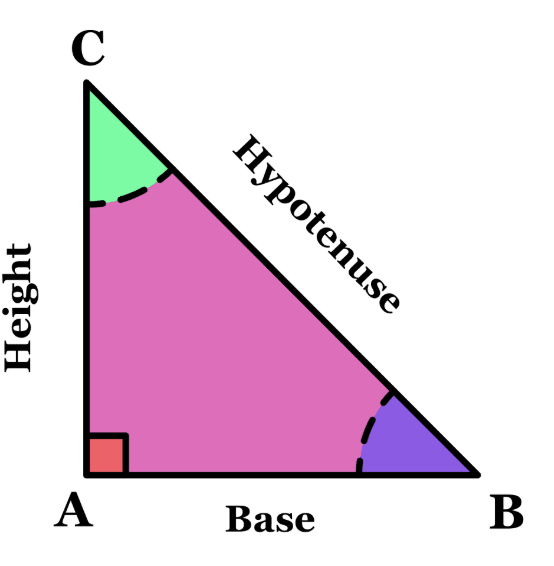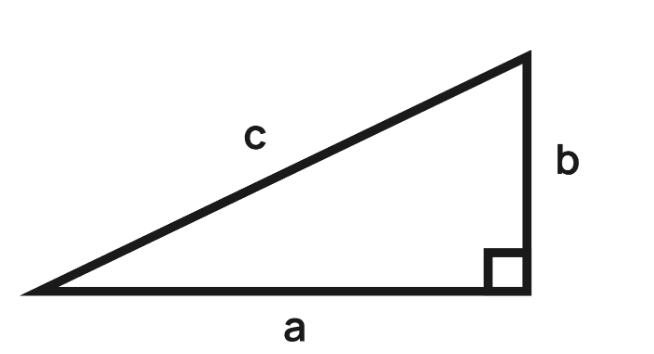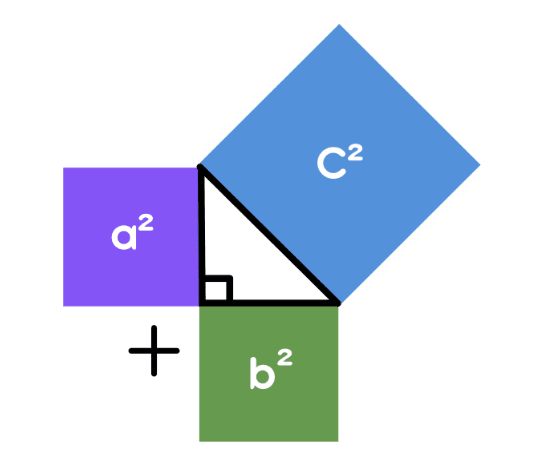Pythagoras Theorem
Introduction
The Pythagoras theorem is one of the most important topic in mathematics and geometry. It is also known as the Pythagorean Theorem and is a fundamental concept. This theorem explains the relationship between the sides of a right-angled triangle. The name originated after the ancient Greek mathematician Pythagoras, who claimed to have proved the theorem. The theorem is not only applicable in mathematics, but it also has broad applications in construction, computer graphics, navigation and science. Let us explore Pythagoras theorem, its formula, and derivation with solved examples. In this article, we'll go through the definition of the Pythagoras theorem, its formula, practical applications and sample example. This page will help you in easily understand and apply the formula for the Pythagoras theorem.
Table of Contents
- What is the Pythagoras Theorem?
- Pythagoras Theorem Formula
- History of the Pythagoras Theorem
- Understanding the Pythagoras Property
- How to Use the Pythagoras Theorem
- Applications of the Pythagoras Theorem in Real Life
- Derivations and Proofs
- Pythagorean Triples
- Advanced Concepts: Coordinate Geometry
- Solved Examples
- Practice Questions
- Conclusion
- FAQs on Pythagoras Theorem
What is the Pythagoras Theorem?
The Pythagoras Theorem, sometimes referred to as the Pythagorean Theorem, states that in any right angled triangle, the square of the longest side is equal to the sum of the squares of the other two sides. In other words, in a right-angled triangle, the square of the hypotenuse is equal to the sum of the squares of the other two sides. Along with mathematics, we apply this theorem widely in construction, navigation, and computer graphics.
For example, for the triangle ABC, AB is the base, AC is the height and BC is the hypotenuse. Thus, BC² = AB² + AC²

Pythagoras Theorem Formula
The Pythagoras theorem is expressed using the formula as shown below:
Hypotenuse2 = Perpendicular2 + Base2
For a right triangle ABC with sides a,b and c the Pythagoras Theorem Formula will be c² = a² + b²

Where:
-
c is the hypotenuse (longest side),
-
a and b are the other two sides.
This rule is called the Pythagoras property, and it only works for right angled triangles. It’s one of the first and most useful geometric rules students learn, especially because it shows up often in daily life.
Understanding the Terms:
- Right-angled Triangle: The triangle where one of the angles is exactly 90.
- Hypotenuse: The longest side of a right-angled triangle.
- Legs: The other two sides, i.e., base and height of a right-angled triangle.
History of the Pythagoras Theorem
This theorem is named after a Greek mathematician and philosopher Pythagoras who lived around 500 BCE. Although, the concept was known even before his time Pythagoras was the first to provide a fixed proof of the theorem, Records from Babylon and India show existance of this rule before thousands of years. Over centuries, this idea has become a key part of math education across the world.
Understanding the Pythagoras Property
Let’s imagine a triangle with a 90 degree angle. If you draw squares on each of its three sides, the area of the biggest square (on the hypotenuse) is exactly equal to the combined area of the other two squares. This visual representation helps us see the pythagoras property in action.
So by Pythagoras Theorem Formula - Area of square “a” + Area of square “b” = Area of square “c”


This relationship gives us a reliable way to calculate missing sides in right angled triangles, even without measuring them physically. This means that if you know any two sides of a right angled triangle, you can find the third.
Example:
If a = 6 and b = 8, what is c?
c² = 6² + 8² = 36 + 64 = 100 → c = 100 = 10
So, the hypotenuse is 10 units long.
This pythagoras formula is used not just in school problems, but also in fields like engineering, physics, navigation, and more.
How to Use the Pythagoras Theorem
Here’s how you can solve real problems using the pythagoras theorem formula:
Finding the Hypotenuse:
If you know the two shorter sides, use c² = a² + b²
Finding a Side:
If you know the hypotenuse and one side, use:
a² = c² b²
Real Life Word Problem:
A ladder leans against a wall. The ladder is 13 ft long, and it touches the wall 5 ft above the ground. How far is the base of the ladder from the wall?
Use c = 13, a = 5
b² = 13² 5² = 169 25 = 144 → b = √144 = 12
The base is 12 ft from the wall.
Applications of the Pythagoras Theorem in Real Life
The pythagoras theorem is incredibly useful and practical in real world situations:
Architecture & Construction
Builders use the pythagoras formula to check if angles are right, ensuring walls and supports are straight and stable.
Navigation & Mapping
When finding the shortest distance between two points (like a plane flying diagonally), navigators use the pythagoras theorem formula.
Sports & Athletics
In soccer or basketball, coaches and players use it to calculate angles and distances between players.
Robotics & Engineering
Engineers use the pythagoras property to design robots, buildings, or even highways with precise measurements.
Computer Graphics & Gaming
The pythagoras theorem helps calculate distance between objects or characters on the screen.
Derivations and Proofs
There are over 300 known proofs of the pythagoras theorem! Here are two popular ones:
A. Geometric Proof
-
Draw a square with side (a + b).
-
Place 4 identical right triangles inside.
-
The empty space forms a square of side c.
-
Use area formulas to derive: c² = a² + b²
B. Algebraic Rearrangement
Using algebra, rearrange squares and triangles to visually show that the formula must be true.
These proofs make the pythagoras formula not just useful, but also fascinating to study.
Pythagorean Triples
Some right angled triangles have sides with whole numbers. These sets of numbers are called Pythagorean Triples. In other words, Pythagorean Triples are special sets of three whole numbers that follow the Pythagoras Theorem.
Examples:
-
3, 4, 5
-
5, 12, 13
-
7, 24, 25
These are helpful for solving problems quickly without a calculator and reinforce the understanding of the pythagoras theorem.
Advanced Concepts: Coordinate Geometry
In coordinate geometry, we use the pythagoras theorem formula to find distance between two points.
Distance Formula:
Distance = √[(x₂ x₁)² + (y₂ y₁)²]
This is directly derived from c² = a² + b², with horizontal and vertical distances forming a right triangle on the graph.
Solved Examples on Pythagoras Theorem
Example 1: Find the base of a right-angled triangle, where the height is 12 cm and the hypotenuse length is 13 cm.
Solution:
Given,
Height = 12 cm
Hypotenuse = 13 cm
Base =?
We know that,
Pythagoras Formula:
Hypotenuse² = Base² + Height²
13² = Base² + 12²
Base² = 13² - 12²
Base² = 169 - 144
Base²=25
Base=25
Base = 5 cm
Therefore, the base of a right-angled triangle is 5 cm.
Example 2: 8, 15 and 17 units are sides of a triangle. Prove that the triangle is right-angled.
Solution:
We know that,
Pythagoras Formula:
Hypotenuse² = Base² + Height²
Base = 8 units
Height = 15 units
Hypotenuse = 17 units [Because the longest side is the hypotenuse side]
Hypotenuse² = Base² + Height²
17² =8² + 15²
289 = 64 + 225
289 = 289
LHS = RHS
Hence, proved that the given triangle is right-angled.
Example 3: The side of a square is 9 cm. Find the length of the diagonal of a square.

Solution:
Given,
Side = 9 cm
Diagonal =?
Let's consider two right-angled triangles, i.e., ADC and ABC.
ADC = ABC
Apply Pythagoras theorem,
In ADC,
AC²=AD² + DC²
AC² = 9² + 9²
AC² = 81+ 81
AC² = 162
AC = 162
AC = 81 x 2
AC=92 cm
Therefore, the length of a diagonal is 92 cm.
Example 4: A sailor sails a ship 12km east and 15km north. Find the distance from the starting point.`
Solution:
Let’s consider BAC
We know that,
Pythagoras Formula:
Hypotenuse² = Base² + Height²
BC² = AC² + AB²
BC² =12² + 15²
BC² = 144+225
BC² = 369
BC = 369
BC = 341 km
Therefore, the distance from the starting point is 341 km
Practice Questions
-
A right-angled triangle has legs of length 7 cm and 24 cm. Find the length of the hypotenuse.
-
A right-angled triangle has a hypotenuse of length 17 inches and one leg of length 8 inches. Find the length of the other leg.
-
A rectangular garden is 12 meters long and 5 meters wide. What is the length of the diagonal of the garden?
-
A baseball diamond is a square with sides of 90 feet. What is the distance from home plate to second base?
Conclusion
The Pythagoras Theorem is a timeless rule that shows the relationship between the sides of a right triangle. From the simple pythagoras formula to its wide use in daily life, the pythagoras property remains a key concept in both education and professional fields. With Pythagorean theorem formula, you can solve countless geometry problems and real world challenges. Whether you're a student or someone who loves math, understanding this theorem gives you a solid base to explore more advanced topics.
Frequently Asked Questions on Pythagoras Theorem
1. What is the full Pythagoras formula?
Answer: The full Pythagoras formula is c² = a² + b², where:
-
c is the hypotenuse (the longest side),
-
a and b are the other two sides of a right-angled triangle.
This formula helps calculate the length of any one side when the other two are known.
2. What is the Pythagorean theorem explain?
Answer: The Pythagorean Theorem states that in a right-angled triangle, the square of the hypotenuse is equal to the sum of the squares of the other two sides. In formula form:
c² = a² + b²
This theorem is used to find distances, heights, and side lengths in geometry and real life applications.
3. How to calculate angle in Pythagoras theorem?
Answer: While the Pythagorean Theorem itself doesn’t give angles, you can find angles using trigonometry with the sides:
-
sin(θ) = opposite / hypotenuse
-
cos(θ) = adjacent / hypotenuse
-
tan(θ) = opposite / adjacent
Then, use a calculator’s inverse functions (like sin⁻¹, cos⁻¹) to get the angle in degrees.
4. How to calculate triangle area?
Answer: The area of a triangle is calculated using the formula:
Area = ½ × base × height
For a right triangle, the base and height are usually the two sides that form the right angle.
5. Is a² + b² = c² only for right triangles?
Answer: Yes, the formula a² + b² = c² is only valid for right-angled triangles. If the triangle does not have a 90° angle, this rule doesn’t apply. For non-right triangles, use the Law of Cosines instead.
Unlock the power of the Pythagoras Theorem and more with simple, engaging math lessons at Orchids The International School.
CBSE Schools In Popular Cities
- CBSE Schools in Bangalore
- CBSE Schools in Mumbai
- CBSE Schools in Pune
- CBSE Schools in Hyderabad
- CBSE Schools in Chennai
- CBSE Schools in Gurgaon
- CBSE Schools in Kolkata
- CBSE Schools in Indore
- CBSE Schools in Sonipat
- CBSE Schools in Delhi
- CBSE Schools in Rohtak
- CBSE Schools in Bhopal
- CBSE Schools in Aurangabad
- CBSE Schools in Jabalpur
- CBSE Schools in Jaipur
- CBSE Schools in Jodhpur
- CBSE Schools in Nagpur
- CBSE Schools in Ahmednagar
- CBSE School In Tumkur











